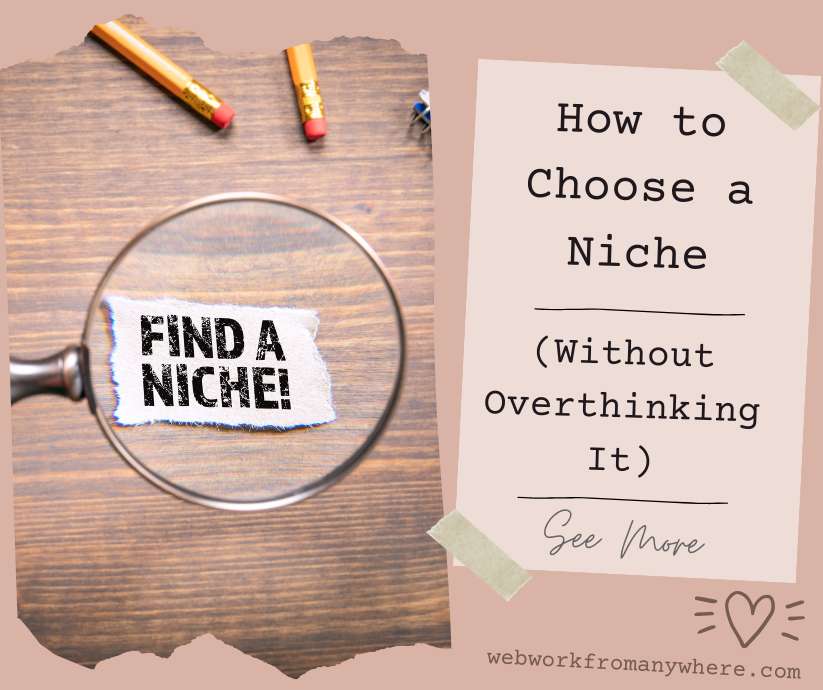The idea of starting a blog, a social media marketing business, or a YouTube channel is exciting, but then you hit the wall: how do you choose a niche? It’s easy to get lost in analysis paralysis, feeling overwhelmed by all the options. Don’t worry, the perfect niche for you isn’t some secret formula. It’s already within your grasp. We’re going to uncover it together, step by step, without the overthinking…
This is Part of the Content and Affiliate Marketing Series
1. Two Simple Secrets
Here’s the truth nobody tells you:
1. The best niche is the one you’ll actually stick with for months (or years) without getting bored.
2. You don’t need to be a world-class expert. You just need to be a few steps ahead of your audience.
2. Start With What You Already Know
Look at your phone’s most-used apps. What do you spend hours researching? What problems do you solve for friends and family?
Your niche might be meal prepping for busy parents. Or budget travel tips for college students. Or organizing small apartments.
These aren’t “boring” niches – they’re goldmines waiting for someone who gets it.
3. The Kitchen Table Test
Imagine you’re at a dinner party. Someone asks what you’re passionate about. What topic makes you light up and talk for 20 minutes straight?
That excitement? That’s your niche talking.
Your enthusiasm will carry you through the tough days when traffic is low and revenue is zero.

4. Check Your Search History
Open your browser history right now. What have you been googling lately?
“Best noise-canceling headphones under $200.” “How to grow herbs indoors.” “Beginner guitar exercises.”
Those searches reveal problems you’re actively trying to solve. Other people have the same problems.
5. The 3 AM Rule
What topic could wake you up at 3 AM and you’d happily discuss it?
For some people, it’s cryptocurrency. For others, it’s dog training or sourdough baking.
That’s your passion talking. Passion creates authentic content. Authentic content builds trust. Trust generates income.
6. Ignore the “Oversaturated” Myth
Every niche has competition. Competition means there’s money to be made.
You’re not trying to dominate an entire industry. You’re trying to help a specific group of people with a specific problem. Think sub-niche.
“Fitness” is broad. “Strength training for women over 40” is specific. Specific wins.
7. The Overlap Sweet Spot
Draw three circles. Label them: “What you know,” “What you enjoy,” and “What people pay for.”
Your perfect niche lives where all three circles meet.
You know about budgeting. You enjoy helping people save money. People pay for financial advice. Boom – personal finance niche.
You May Also Like
- Guide to Affiliate Marketing for Beginners
- 10 Social Media Marketing Courses for Beginners
- Is Rocket.net Good for Beginners?

8. High-Buying Power Niches vs. Research-Only Niches
Here’s a reality check: some niches love to buy, others just love to browse.
High-Buying Power Niches
- Health and fitness (supplements, equipment, courses)
- Personal finance (tools, courses, books)
- Home improvement (tools, materials, tutorials)
- Pet care (food, toys, training)
- Beauty and skincare (products, treatments)
- Business and entrepreneurship (software, courses, coaching)
- Parenting (products, educational materials)
- Technology and gadgets (reviews drive purchases)
Research-Heavy, Low-Buying Niches
- Celebrity gossip (high traffic, low purchases)
- Pure entertainment content
- Historical facts and trivia
- Free life hacks and tips
The difference? Pain points vs. entertainment.
People spend money to solve problems. They spend time to be entertained.
Pick niches where people have genuine problems they’ll pay to solve.

9. The Money Question
Before you commit to any niche, ask yourself: “Do people in this space actually buy things?”
Look at Facebook ads in your potential niche. Check Amazon for related products. Browse Pinterest for affiliate links.
If you see ads and products everywhere, that’s a buying audience. If you only see free content and blog posts, that’s a browsing audience.
You want buyers, not just browsers.
10. Test Before You Commit
Spend one week creating content in your potential niche. Write three blog post titles. Film one YouTube video. Post on social media.
But also research the buying behavior. Check affiliate programs in your niche. Browse Amazon’s bestsellers in related categories.
How did content creation feel? Did ideas flow naturally? Did you enjoy the process?
More importantly – did you find plenty of products and services people actually purchase?
If yes to both, you’ve found your niche. If no, try another angle.
11. The Good Enough Rule
Your first niche doesn’t have to be perfect. It just has to be good enough to start.
You can always pivot later. Many successful creators started in one niche and evolved into another.
The key is starting. Not planning to start. Actually starting.
12. Common Beginner Mistakes to Avoid
Don’t chase shiny objects. That “AI-generated passive income” niche might look appealing, but can you create authentic content about it?
Don’t pick a niche solely based on potential earnings. Money follows passion, not the other way around.
Don’t wait for more research. You already know enough to begin.

13. Your Niche Doesn’t Define You Forever
You’re not signing a lifetime contract. Your niche can evolve as you grow.
Start narrow. Get good at serving one specific audience. Then expand if you want to.
“Vegan recipes for beginners” can become “Healthy eating for busy professionals” later.
14. The Simple Next Step
Right now, write down three topics you could talk about without notes for 30 minutes.
Pick the one that excites you most.
That’s your niche.
Tomorrow, create your first piece of content. Don’t edit it to death. Just publish it.
Your audience is waiting for someone exactly like you to show up and help them.
How to Choose a Niche (without overthinking it)
Stop overthinking and start creating. Your perfect niche isn’t hidden in market research – it’s in your existing knowledge and genuine interests. Pick something you enjoy, test it for a week, and adjust as you go. The internet needs your unique perspective, not another cookie-cutter approach.
See Also in This Series
Latest Advice
- Guide to Affiliate Marketing for Beginners
- What Hobbies Can I Teach Online? (Turn Your Craft into Profit)
- Hot Tips to Boost Your Hobby Teaching Income
- Landingi Landing Pages Explained – Quick Guide
- Best Eco-Friendly Products to Sell on Amazon FBA for Beginners
- 4 Best Landing Page Builders for Beginners (my top picks)






